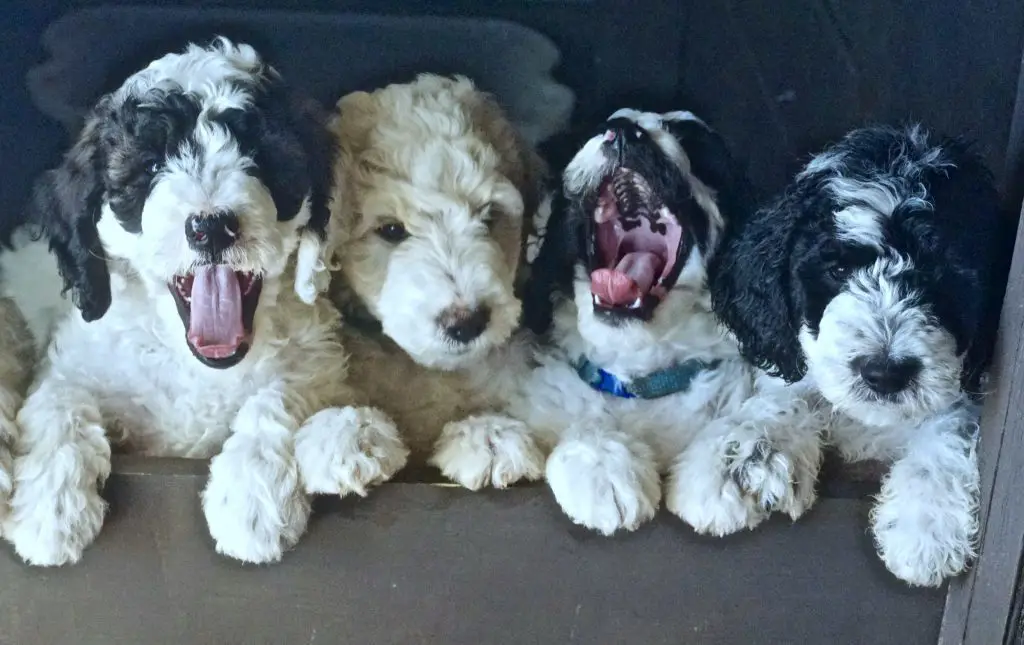Designer dogs like Goldendoodles are increasingly popular.
They come in different variations since the Poodle and Golden Retriever parents have diverse genetic makeups. These differences depend on;
- Size
- Generations
- Colors
- Coat types and textures
The traits inherited by the offspring are a genetic gamble and will depend on the parent’s traits. No guarantees can be made on how a puppy will turn out
Goldendoodle Generations
| Generation | Description |
| F1 Goldendoodle (Filial 1) | 1st generation cross 50% Poodle X 50% Golden Retriever Has strong hybrid vigor Tends to shed more than other generations |
| F1b Goldendoodle | 1st generation backcross F1 Goldendoodle X Poodle or Golden Retriever The Poodle is preferred for 3/4 Poodle, 1/4 Golden Retriever that sheds less |
| F1bb Goldendoodle | 1st generation double-backcross F1b Goldendoodle X Poodle or Golden Retriever |
| F2 Goldendoodle (Filial 2) | 2 generation cross F1 Goldendoodle X F1 Goldendoodle Increased genetic diversity and unpredictability Vary in size, coat types, and shedding |
| Multigen Goldendoodles | Any generation beyond the 1st generation cross Optimization for certain Poodle or Golden Retriever qualities |
Goldendoodle sizes
As a hybrid dog, it is impossible to predict how big your Goldendoodle puppy will be. However, below are some of the predictions based on what has been observed on full-grown mixed dogs
Below are the 3 typical sizes;
| Standard Goldendoodle | Mini Goldendoodle | Toy Goldendoodle |
 |  | 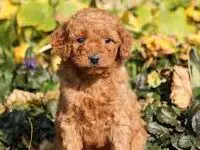 |
| Weight:50-70 pounds | Weight:25-50 pounds | Weight:10-25 pounds |
| Height:20-26 inches | Height:15 -20 inches | Height: Under 15 inches |
| Cost:$1,500-$2,500 | Cost:$1,600-$2,600 | Cost:$900-$2400 |
| Lifespan:10-15 years | Lifespan:10-15 years | Lifespan:10-15 years |
Goldendoodle colors
Goldendoodles come in a variety of colors and patterns that include
- Black
- Blue/gray
- Silver
- Silver Beige
- Chocolate/brown
- Red
- Apricot
- Tan
- Champagne
- Cream
- Chalk white
- Merle
- Parti
- Sable
- Phantom
- Tuxedo
- Tri-color
- Brindle
- Abstract
These colors are created by alterations of 2 melanin pigments or a lack thereof. These pigments are;
- Eumelanin is default black, chocolate or grey. This pigment is also responsible for black noses and brown eye colors. If the pigment is modified (brown gene) the nose will be pinkish (rose) and the eyes amber. Eumelanin is affected by brown, dilution, merle, and greying genes.
- Phaeomelanin is yellow, red, cream, apricot, tan, and so on depending on the intensity of the pigments. It is only visible on hair color and not the eye, skin, or nose color.
Color genetics
The coat color and intensity are determined by the genes inherited from the parents. Variations of these color genes (alleles) alter how the colors are expressed. These genes are found in different positions on a dog’s chromosome.
There are 6 main gene positions (Loci) that affect a Goldendoodle’s color. These are the K, A, E, B, G, M, and S loci.
K locus (Dominant black):
This is where the dominant black gene (K) is located and is responsible for the default black coat (eumelanin).
The K locus consists of 3 alleles;
- Dominant K- Produces black. Black is dominant and a dog with a capital K will have a solid black or chocolate coat. The nose will be black with eyes that are almost always brown. The dominant black gene (Kb) is dominant over the A-locus but can be modified by brown, dilution, greying, and merle genes. These genes alter the shade of the black pigment but cannot add red pigments to the coat or skin. Any Goldendoodle with dominant K may be genetically red or sable but they won’t be expressed due to the dominance of the gene. Red pigments can only be added to the coat through the recessive red gen on the E-locus (e/e). The coat will be turned solid red but retain a black nose if the E-locus is e/e.
- Kbr– Produces brindle pattern. 2 copies are required for a brindle coat (kbr/kbr). This gene is dominant over small k but recessive over Kb.
- Recessive k– Non-black and allows black, red, and tan markings to show but with a black nose. 2 copies of these alleles should be present for red marking to show. How these red markings show is determined by the A locus.
When other genes interact with the K locus, other shades such as liver, blue, grey, and silver come about.
A locus (Agouti):
This is the location of the Agouti (ASIP) gene that affects whether eumelanin or phaeomelanin is produced, distribution, and specific patterns.
In its dominant form (A), the gene promotes the production of red pigments (phaeomelanin). But the recessive mutant variant (a) promotes eumelanin production when 2 copies of the recessive allele are present for a black coat.
However, the A-locus can only shine through if the doodle has a pair of recessive k alleles (k/k). when the dog has a dominant K gene, the genes on the A-locus though present will not show.
There are 4 known variants of this gene;
- Ay– The dog will have a fawn color (yellowish tan). This allele is dominant over others in the gene and their presence will not matter
- aw– Switches between eumelanin and phaeomelanin as the hair grows for a sable coat (wolf sable gray). 2 copies of the gene (aw/aw) are required for the color to be expressed.
- at– Produces tan markings. The dog will be tan or black or tricolor
- a– Produces a solid black coat. a/a will have a black coat
Locus E and K affect the expression of the A locus. In the presence of e/e genotype and K allele, the A locus is not expressed.
E locus (Extension):
This locus affects all non-agouti eumelanin and phaeomelanin distribution and patterns. It determines which area of the coat produces eumelanin and which produces phaeomelanin.
In its dominant form (E), the gene allows for the expression of the K, B, and A-locus for eumelanin production. However, with 2 copies of the recessive variant (e/e), the coat will be completely red (or red shades such as yellow, apricot, cream, etc) as it only promotes the production of phaeomelanin. It is genetically impossible for a red dog to have a black or brown coat but will not affect the skin, eye, and nose color
The recessive red (e/e) dominates all other loci except for white.
B Locus (Brown):
This locus contains the gene that modifies eumelanin only to produce a liver (rich brown) color. the gene is recessive and thus b is brown/liver/chocolate while capital B (Dominant) is non-liver. 2 copies of b (b/b) are required to modify black to brown.
All black hair will be tuned to brown as it is genetically impossible for the doodle to have any black hair. The nose will be brown or pinkish (rose), the paw pads brown, and the eyes amber.
Some Goldendoodle can be born with a red coat (e/e) but still, be genetically brown if the nose is brown or rose. This is because the brown gene does not affect phaeomelanin pigments.
G Locus (Greying):
This is the home of the greying gene in Goldendoodles. It affects how intense the eumelanin pigments are over time.
The greying gene is dominant (G) and only affects the black pigments on the coat. Only one copy of the gene is required for progressive greying to occur as the dog ages.
The gene does not affect the nose or eye color but the black or brown coat will lighten as the pup gets older.
M Locus (Merle):
The M locus affects the intensity of eumelanin. In its dominant form, it creates random irregular patches of dilutes and solid color.
A black dog with a merle pattern is known as blue merle while a brown dog with the merle pattern is known as red merle
S locus (White spotting):
S locus affects the distribution of white random and irregular patterns such as parti. The recessive gene causes some parts of the coat to be white where no eumelanin and phaeomelanin pigments are produced. Rarely is the entire coat affected for a completely white coat.
There are 4 variants of the S allele;
- S– solid color with no white pigmentation
- si– White spots- often seen on the collar, legs, and belly
- sw– extreme white spotting due to a lack of or production of less pigment
- sp-piebald– Produces irregular white spotting depending on the number of mutant alleles
Black Pigment color shades
Black pigment dogs must have dark brown eyes. Depending on the number of eumelanin produced and distributed to the hair shaft will give you different shades that include;
- Chocolate
- Gray
- Silver
- Cafe or Silver Beige
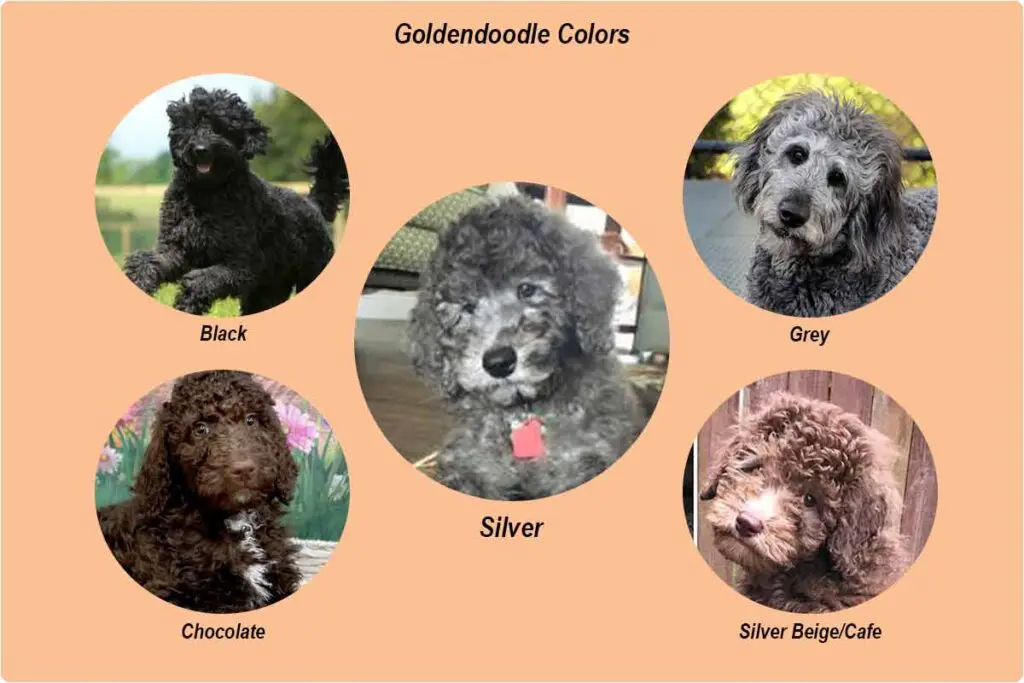
| Colors | Description |
| Black Goldendoodle | The entire coat tends to be pure black with no markings. Some may develop a Bluish, charcoal, or silver hue as they age due to the fading gene Eyes: Dark brown Nose: Black Paw pads, lip, and eye rims: Black Nails: Black |
| Chocolate/Brown/Liver Goldendoodle | Are born quite dark, rich chocolate color – almost black- and may fade with age A true Chocolate Goldendoodle should not fade Markings are accepted but not desired This color is described as deep and rich mahogany to dark walnut color Usually F1b and beyond Eyes: Dark amber to pale hazel-green Nose: Rose, brown, or liver Paw pads, lip, and eye rims: Liver or brown Nails: Dark brown |
| Gray Goldendoodle | Are born almost black and develop a dark to medium smoky blue-gray coat as they age over 1 to 3 years from as early as 6 weeks. Tends to appear as Multi-colored and is rarely a solid color Similar to Silver Goldendoodles but darker and steelier Best described as a pale, dark grey color with a bluish undertone Eyes: Dark brown Nose: Blue-gray Paw pads, lip, and eye rims: Dark brown Nails: Black |
| Silver Goldendoodle | Are born dark chocolate and lighten or fade into a silver-grey or light-grey color in 1-3 years A solid color is preferred but uneven layering is acceptable. May have darker or lighter patches Often confused for gray Goldendoodles early on but is lighter and shinier with age Eyes: Dark amber to pale hazel-green Nose: Rose, brown Paw pads, lip, and eye rims: Dark brown Nails: Dark brown |
| Silver Beige/Cafe au lait Goldendoodle | Born dark beige brown and develop a silver shade with age as early as 6 weeks Is a lighter shade of silver with a light brown color and lighter hair roots Some have faces covered by silver fur Eyes: Dark amber to pale hazel-green Nose: Rose, brown Paw pads, lip, and eye rims: Dark brown Nails: Dark brown |
Red & yellow shades
You can get a range of colors from the phaeomelanin gene depending on the intensity of the pigments. These shades include;
- Deep red
- Cream
- Apricot
- Chalk white
- Caramel
- Champagne
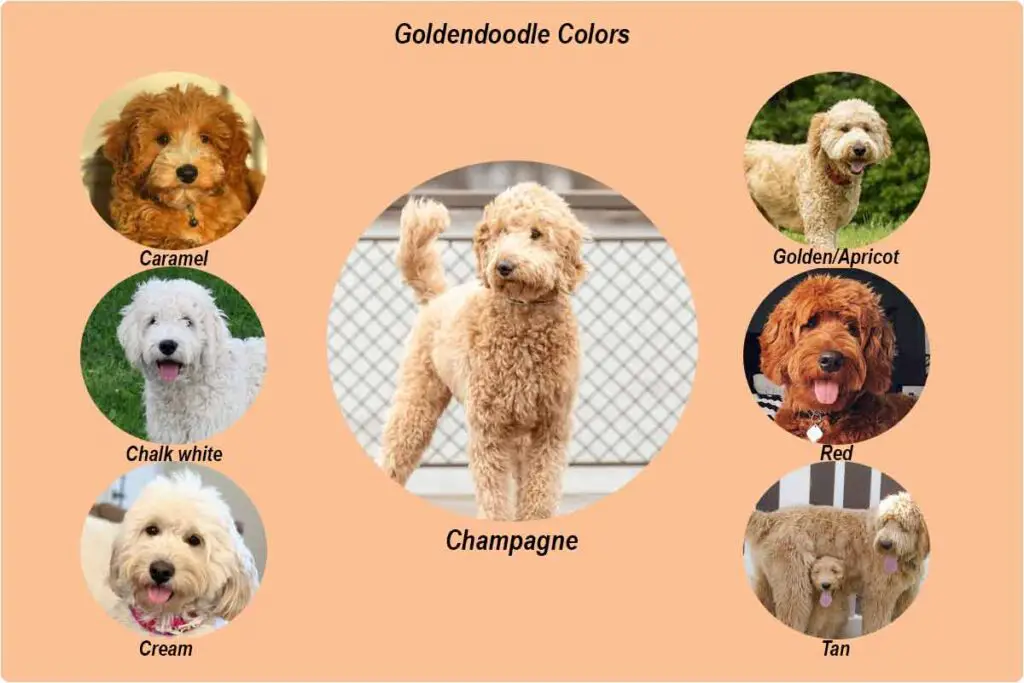
| Colors | Description |
| Red Goldendoodle | Ranges from light to a rich dark red but can fade and tan as the dog matures The entire coat should be a rich solid red and even from the base to the tip with no markings Resembles a teddy bear Eyes: Dark brown Nose: Black Paw pads, lip, and eye rims: Black Nails: Black |
| Tan Goldendoodle | Described as mid-tone brown or a subtle reddish color Has lighter apricot, cream, or white shades mixed into their coats Eyes: Dark brown Nose: Black Paw pads, lip, and eye rims: Black Nails: Black |
| Cream Goldendoodle | Is a shade that appears darker than white. It comes in various shades ranging from a light creamy yellow to a deep cream color that is almost red Often confused for the chalk-white Goldendoodle due to how light they are but tend to be darker Goldendoodles with brown noses are referred to as caramel cream Appear on multi-colored Goldendoodles (merle, phantom, parti) with gold and apricot markings on the paws and face Eyes: Various shades of brown Nose: Brown or rose Paw pads, lip, and eye rims: Dark brown or rose Nails: Light nails |
| Champagne Goldendoodle | Have light cream coats with a golden yellowish tinge Cream and Champagne Goldendoodles are somewhat similar but champagnes are more colorful Puppies may be born dark brown and fade over time from about 6 weeks Eyes: Various shades of brown Nose: Brown or rose Paw pads, lip, and eye rims: Dark brown or rose Nails: Light nails |
| Caramel Goldendoodle | Is a rich shade of cream ranging from rich gold to a deep red shade Should be a consistent color but may have hints throughout the coat Eyes: Hazel to amber Nose: Dark brown or rose Paw pads, lip, and eye rims: Liver or brown Nails: Dark brown |
| Apricot or Golden Goldendoodle | Rich dark golden brown color resembling the inside of apricot This is a shade between red and brown Should be a consistent coloration from the root to the tip of the hair shafts May lighten over time to pale orange yellow Can be confused for Cream or tan Goldendoodles but have black noses Eyes: Dark brown to hazel-green eyes Nose: Black Paw pads, lip, and eye rims: Black Nails: Black |
| Chalk-white Goldendoodle | Is white but appears creamier or darker when put against a white backdrop more like chalk Others may have deeper chalk-white facial markings Eyes: Dark brown to hazel-green eyes Nose: Black or rose Paw pads, lip, and eye rims: Black or rose Nails: Black or light |
Coat patterns
- Brindle
- Abstract
- Parti
- Merle
- Tuxedo
- Phantom
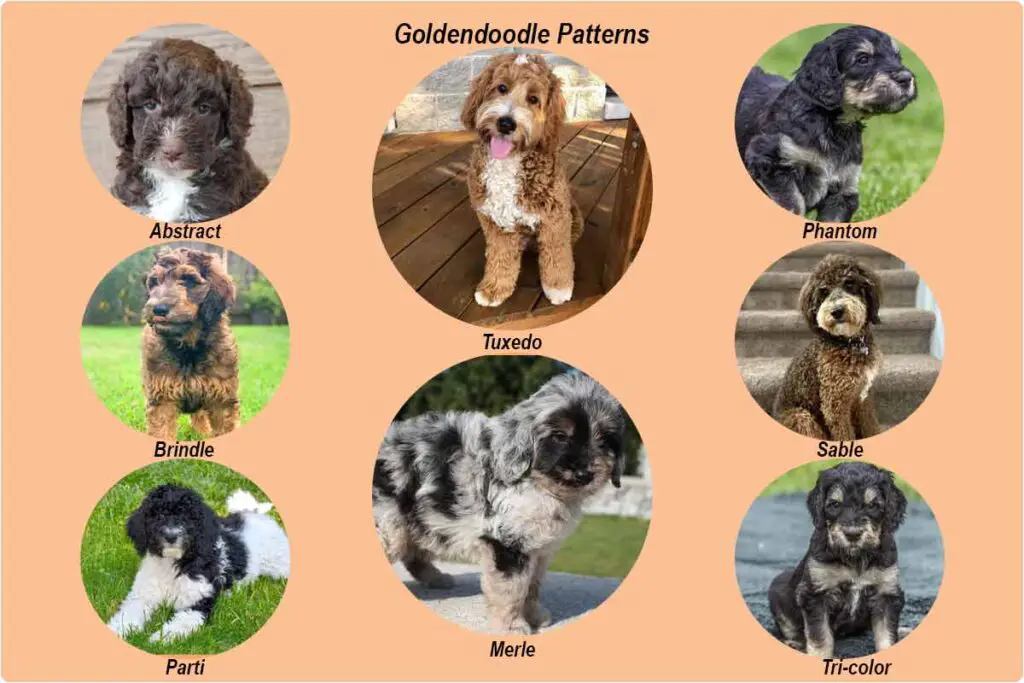
| Patterns | Description |
| Solid color | Only one single color of any color such as chocolate, red, and so on No markings |
| Tuxedo Goldendoodle | Is a variation of the parti coat with white markings making up less than 50% Are part black and part white The non-white parts can be any color including brown Has distinct and predictable white markings on the legs, chest, tummy, forehead, and nose as if the dog is wearing a tuxedo |
| Parti Goldendoodle | Contains a coat that is at least 50% white with secondary random patches of any color such as chocolate, red, silver, apricot, tan, etc The patches should be clear and defined with no particular shape thus no two parti pups are alike Patches normally appear on the face, chest, feet, under the tail, around the eyes, ears, and saddle The secondary color is the same for the eye and lip rims, nose and eye color |
| Sable Goldendoodle | Is Gold, Chocolate, gray, red, or any base color with black tips overlaying the base color for a two-tone appearance Has no predictable pattern Are born black and fade with age into a lighter cream or tan shade Some of the body parts remain black with spots on the ears, face, and other areas The distribution of the darker tips can be even or uneven |
| Phantom Goldendoodle | They have a solid base color such as black or brown sporting particular sharply defined markings of any second color such as white, silver, gold, or cream The markings appear on the eyebrows, cheeks, throat, below the chest, below the tail, inner lower legs, and the sides of the muzzle Common combinations are; – Black and gold – Black and tan – Black and cream – Silver and brown – Cream and brown Some are a 3-color combination The nose can be black or rosy |
| Merle Goldendoodle | Consists of random, unique, and irregular patches of black, red, or chocolate, apricot, blue-gray, silver, and cream on a solid base color. This results in a marbling effect Oftentimes, the patches are silver or blue on a black, brown, or white coat These dogs have incredible blue, amber, or dark-colored eyes If two merle parents are bred together, the merle genes can cause deafness and blindness |
| Brindle Goldendoodles | Typically appears as black stripes on a red base. The stripes vary in intensity and width similar to tiger stripes These stripes are best seen on large body parts such as the back The base color can be red, cream, apricot, blue, or silver. Long, wavy or curly hair can make it hard to identify brindle markings |
| Tri-color Goldendoodle | Consists of 3 colors of at least 30% white, a second color usually black or brown, and a third tan color on the eyebrows, chest, lower legs, muzzle, and other phantoms points No tri-color Goldendoodle is 100% Goldendoodle as the gene responsible does not typically appear on Poodles or Golden Retrievers. Usually, they have another breed such as the Bernese Mountain dog in them |
| Abstract/Mismark/Chrome Goldendoodle | Abstract Goldendoodles have a solid base color with less than 30% white markings of no particular patterns or order The base can be any other color such as red or apricot on the chest, paws, tail tip, chin, or forehead Often confused for Tuxedos but have no white bellies The nose should be rosy, black, or brown, matching the base color. The eyes can be blue, black, or brown. |
Goldendoodle color change
Some Goldendoodles puppies may hold their coat color into adulthood. However, you should understand that some pup’s coat color will lighten with age (clearing). Even then, some parts of the pups such as the ears and muzzles may hold their color into adulthood. The color change is commonplace.
It is best practice to choose a color that is darker that the anticipated adult color as it is likely to fade as the adult coat develops. A black Goldendoodle may fade into gray while an apricot one may change to cream, chocolate to light brown, and so on. Typically, clearing occurs within the first 3 years.
This color change is more prevalent and dramatic in Black doodles and the difference may be day and night. If you plan to get a Black Goldendoodle, this is something to keep in mind.
Goldendoodle coat types
The appearance of a Goldendoodle is also determined by coat features such as curls, hair, texture, and length.
There are 3 Goldendoodle coat types;
- Curly coats
- Wavy or fleece coats
- Straight or hairy coats

| Coat type | Description | Genotype |
| Fleece or wavy coated Goldendoodle | This is the most common coat type preferred for the low shedding properties and ease of grooming. The coat is wavy to silky with loose shaggy, free-flowing, and soft curls of 4 to 7 inches if not trimmed This coat can range from almost straight, wavy, or forming soft spirals | N/C |
| Wooly or Curly coats | This is the coat type you would get from a purebred Poodle It is dense with tight and compact curls This coat is thick, soft, curly, and dense similar to sheep’s wool. The curls range from loose hollow spirals to tight curls that loop over themselves The coat should not be overly dense Gives an afro look when brushed | C/C |
| Straight or hair-coated Goldendoodle | This coat is straight and more similar to Golden Retriever’s coat It varies in length and thickness Has a light to moderate seasonal shedding The coat may change from puppyhood to adulthood and during hormonal changes in fertile females The coat ranges from 2-5 inches in length | N/N |
Coat Length
Both Poodles and Golden Retrievers have long coats. As such both parents carry the genes for longhaired coats which is a recessive trait. All Goldendoodles will thus have long coats as each parent will contribute a copy of the long coat allele for the l/l genotype.
Coat furnishings
Furnishings are long leg and facial hairs such as eyebrows and beards, characteristic of doodles as the Goldendoodle (Doodley coat). The gene responsible is dominant and thus only one copy of the F allele (FF) is required for a dog to inherit the trait.
A Goldendoodle without furnishings (ff) is said to have an improper coat as furnishings are part of the breed standard. A Goldendoodle with furnishings has a proper coat and shed less compared to those without. This is because furnishings confer to a low or non-shedding coat
But being low shedding is not a guarantee that the dog will be hypoallergenic as allergies are complex- shedding is only a small part of the equation. Allergens can be found in saliva, dander, and skin flakes that may all trigger an allergic reaction.
To Sum up
When buying a Goldendoodle, do not base your decisions on color alone. Health and the dog’s personality are far more important when it comes to selection before gravitating to looks. Although it is the first thing you notice, no color or pattern is better than the other.
The is no link between color and a dog’s personality.
However, some colors such as merle have been linked to genetic defects that cause deafness or blindness if the pup inherits two copies of the dominant merle gene. As such as you should always seek out a responsible breeder for a purchase.
All in all, Goldendoodles are loving, playful, and excellent family dogs whose company you will love.
There you go, WOOF!
